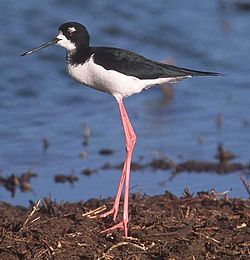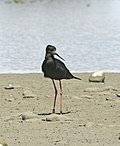Recurvirróstridos: Diferenzas entre revisións
Contido eliminado Contido engadido
| Liña 26: | Liña 26: | ||
Their vocalizations are usually yelps of one or two syllables.<ref name=B&T/> |
Their vocalizations are usually yelps of one or two syllables.<ref name=B&T/> |
||
== Distribución e hábitat == |
|||
==Distribution and habitat== |
|||
Avocets and stilts are a [[cosmopolitan distribution|cosmopolitan]] family, being distributed on all the world's continents except Antarctica, and occurring on several oceanic islands. Several species are wide-ranging and a few are locally distributed. |
Avocets and stilts are a [[cosmopolitan distribution|cosmopolitan]] family, being distributed on all the world's continents except Antarctica, and occurring on several oceanic islands. Several species are wide-ranging and a few are locally distributed. |
||
One species, the [[black stilt]] of [[New Zealand]], is [[critically endangered]] due to [[habitat loss]], [[introduced species|introduced predators]], and hybridisation with the [[pied stilt]]. |
One species, the [[black stilt]] of [[New Zealand]], is [[critically endangered]] due to [[habitat loss]], [[introduced species|introduced predators]], and hybridisation with the [[pied stilt]]. |
||
== |
== Alimentación == |
||
Estas especies aliméntanse de pequenos animais acuáticos como [[molusco]]s, [[camarón]]s e outros [[crustáceos]], larvas de [[insecto]]s, [[anélidos]], [[cágado]]s e pequenos [[peixe]]s. |
|||
== |
== Reprodución == |
||
Stilts and avocets breed on open ground near water, often in loose [[bird colony|colonies]]. They defend nesting territories vigorously with aggressive displays, and mob intruders and possible predators with a great deal of noise.<ref name=B&T/> They are [[monogamy|monogamous]], although the pair bonds are not maintained from season to season. Their eggs are light-coloured with dark markings, weighing {{convert|22|to|44|g|oz|abbr=on}}.<ref name=B&T/> Three to four are laid in simple [[bird nest|nests]], and both parents share the [[avian incubation|incubation]] duties, which last 22 to 28 days.<ref name=B&T/> The banded stilt may breed only every few years, as it breeds on temporary lakes caused by rains in the deserts of Australia. The chicks are [[down feathers|downy]] and [[precocial]], leaving the nest within a day of hatching;<ref name=B&T/> they fledge in 28 to 35 days.<ref name=B&T/> In all species except the banded stilt, the chicks are cared for by the parents for several months, and they may move them to new areas and defend territories there.<ref name=B&T/> Banded stilts deviate from this by collecting their chicks in massive [[Crèche (zoology)|crèches]] numbering several hundred. |
Stilts and avocets breed on open ground near water, often in loose [[bird colony|colonies]]. They defend nesting territories vigorously with aggressive displays, and mob intruders and possible predators with a great deal of noise.<ref name=B&T/> They are [[monogamy|monogamous]], although the pair bonds are not maintained from season to season. Their eggs are light-coloured with dark markings, weighing {{convert|22|to|44|g|oz|abbr=on}}.<ref name=B&T/> Three to four are laid in simple [[bird nest|nests]], and both parents share the [[avian incubation|incubation]] duties, which last 22 to 28 days.<ref name=B&T/> The banded stilt may breed only every few years, as it breeds on temporary lakes caused by rains in the deserts of Australia. The chicks are [[down feathers|downy]] and [[precocial]], leaving the nest within a day of hatching;<ref name=B&T/> they fledge in 28 to 35 days.<ref name=B&T/> In all species except the banded stilt, the chicks are cared for by the parents for several months, and they may move them to new areas and defend territories there.<ref name=B&T/> Banded stilts deviate from this by collecting their chicks in massive [[Crèche (zoology)|crèches]] numbering several hundred. |
||
--> |
--> |
||
== Taxonomía == |
== Taxonomía == |
||
A taxonomía dos recurvirróstridos é moi debatida, e o xénero ''Himantopus'' se considerou que tiña dous ou seis especies. |
A taxonomía dos recurvirróstridos é moi debatida, e o xénero ''Himantopus'' se considerou que tiña dous ou seis especies. |
||
Revisión como estaba o 2 de marzo de 2019 ás 23:52
Este artigo está a ser traducido ao galego por un usuario desta Wikipedia; por favor, non o edite. O usuario Miguelferig (conversa · contribucións) realizou a última edición na páxina hai 5 anos. Se o usuario non publica a tradución nun prazo de trinta días, procederase ó seu borrado rápido. |
| Recurvirróstridos | |||||||||||||
|---|---|---|---|---|---|---|---|---|---|---|---|---|---|
 Himantopus mexicanus knudseni de Hawai | |||||||||||||
| Clasificación científica | |||||||||||||
| |||||||||||||
| Xéneros | |||||||||||||
Os recurvirróstridos (Recurvirostridae) constitúen unha familia de aves limícolas da suborde Charadrii. Contén dous grupos distintos de aves, as avocetas (un xénero) e as pernalongas ou patudas (dous xéneros). En Galicia viven as especies Recurvirostra avosetta e Himantopus himantopus.
Descrición
Taxonomía
A taxonomía dos recurvirróstridos é moi debatida, e o xénero Himantopus se considerou que tiña dous ou seis especies.
Notas
| Commons ten máis contidos multimedia sobre: Recurvirróstridos |
Véxase tamén
Bibliografía
- Pierce, R.J. (1996) "Family Recurvirostridae (Stilts and Avocets) P.p. 332-348 in del Hoyo, J.; Elliot, A. & Sargatal, J. (editors). (1996). Handbook of the Birds of the World. Volume 3: Hoatzin to Auks. Lynx Edicions. ISBN 84-87334-20-2











